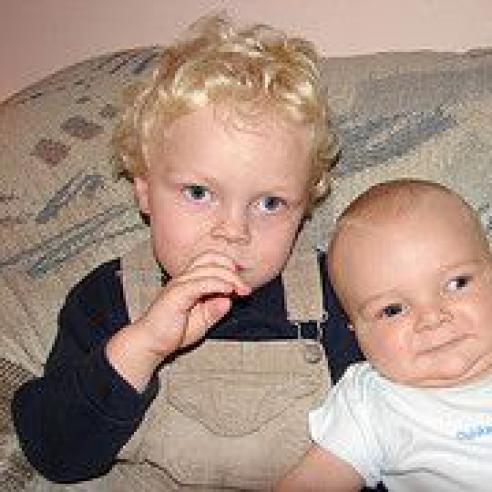Crossed Eyes
[Note: this is an older, but still potentially useful, article from the RPB archives.]
Eugene R. Folk, MD, Professor
The eyes should work together as a team. When one eye is deviated (turned too
far in one direction), we call the condition strabismus, or crossed eyes.
Strabismus occurs most often in young children. A child with strabismus may
have esotropia (one eye turning in), exotropia
(one eye turning out), or hypertropia (one eye higher than the
other).
There are many causes for this breakdown in binocular vision. Most commonly, strabismus is inherited. In other patients, a deviation will result from a high degree of farsightedness. Strabismus also may occur after a loss of vision in one eye due to a disease process. (Esotropia is sometimes the first sign of a tumor in the eye of a child.) When there is a loss of vision in one eye, children under the age of four years will usually develop esotropia, whereas the older patient generally develops exotropia. Another cause of an eye deviation may be damage to one of the three nerves supplying the muscles that move the eye. In most cases, the muscles themselves are normal, but the coordination mechanism is defective.
If the eyes do not focus together, the patient has double vision (diplopia). To avoid this double vision, the child learns to ignore or suppress the picture in the deviating eye. Habitual suppression of one eye causes that eye to become lazy, or amblyopic. The vision becomes poor and cannot be improved with glasses. Amblyopia usually does not develop in children over the age of four years.
Fortunately, strabismus can be treated. The earlier that treatment is instituted, the better the final result. While a certain amount of deviation may be considered normal in infants' eyes, a deviation still present at five months, and certainly by six months of age, must be considered abnormal, and the infant should be evaluated by an ophthalmologist. Similarly, any child who develops a deviation after six months of age should be brought promptly to an ophthalmologist for evaluation. Children do not outgrow strabismus.
The evaluation begins with a thorough eye examination. The eye movements are observed, and the fixation pattern (how the child uses each eye) is determined. In this way a lazy eye can be detected in infants. If the child is noted to prefer using one eye, occlusion therapy (patching of that eye) can be instituted. Using only the lazy eye helps the child develop better vision in that eye. A dilated examination of the back of the eye is of prime importance to verify that there is no eye disease responsible for the - deviation. At the same time, it is possible to determine, even in the small infant or newborn, if the child is nearsighted or farsighted. If a high degree of farsightedness is noted during the exam, the deviation may be corrected with the proper glasses. Glasses can be helpful in children as young as six months of age. They are most effective in treating the esotropic child, whose eyes turn in, and about one third of all such children will have their deviation corrected with glasses alone. Usually the child with exotropia or hypertropia will require surgery to correct the deviation. Eye exercises can be helpful once the eyes have been straightened with glasses or surgery. However, with the tendency toward early surgery, eye exercises have played a lesser role in the treatment of strabismus and are usually unnecessary. Furthermore, most children have to be at least four years of age before they can benefit from any type of eye exercises.
A great deal of progress has been made in the surgical treatment of strabismus. It is no longer the frightening experience it once was. The child is brought to the hospital on the day of surgery, is operated on, and is able to go home the same day. Parents are encouraged to be with their child as much as possible and are separated from the child only during the surgical procedure itself. As soon as the child starts to wake up in the recovery room, the parents are brought in.
The surgery consists of strengthening a muscle by cutting out a small piece of its tendon or weakening a muscle by moving the position where the muscle attaches. At no time is there an incision into the eyeball.
Because of newer techniques and a more accurate assessment of the problem, the treatment of strabismus is quite successful. Most deviations can be corrected with one surgical procedure.
Despite these excellent results, ophthalmologists are constantly striving to improve the success of strabismus treatment. The Pediatric Ophthalmology and Strabismus Service at the University of Illinois at Chicago is participating in a multicenter study, the Prism Adaptation Study, which is evaluating the importance of newer diagnostic modalities.December 27, 2007
Related News: Strabismus

Eye Divergence in Children Linked to Risk of Mental Illness
Children whose eyes are misaligned and point outward are at significantly increased risk of developing mental illness by early adulthood, according to findings of an RPB-supported, Mayo Clinic study published in...
Subscribe
Get our email updates filled with the latest news from our researchers about preventing vision loss, treating eye disease and even restoring sight. Unsubscribe at any time. Under our privacy policy, we'll never share your contact information with a third party.
| General Info | Grants | News & Resources |



